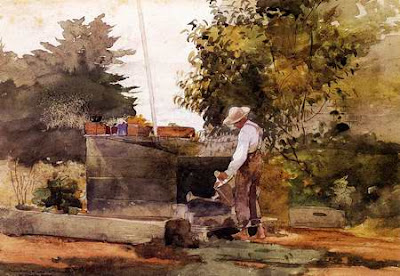Winslow Homer and the Cure for What Ails You (Part 2)
In Part 1 of this post I examined the center section of this Winslow Homer watercolor in detail. It ran long, so I moved my conclusion to this separate post. You can read that previous post here. And there's a couple of other Homer paintings for you.
Here's the concluding thought inspired by this terrific little watercolor-
Whenever I analyse a painting like this some readers wonder if I haven't gone too far and started projecting my own ideas onto poor Winslow Homer's art. I honestly don't think so. Homer had a lot to show us. But he spoke little about his paintings. Instead he spoke to us through a visual language. He himself had "read the classics" by studying the works of the best artists who'd trod the path before him. Each of them had built upon the achievements of artists who'd gone before and each had added a few words to the common vocabulary painters use to weave their tales.
I don't think it's necessary for art lovers to pick apart paintings in such detail. More important is to stand back and let the paintings wash over you. Don't think too much as it can derail the sensation. But for painters, we have an extra job. We have to peel off the outer layers and study the mechanics of great paintings. That means study, it means practice. We are taking our place in the great line of artists that stretch all the way back- Homer to Monet, on to Turner, to the Dutch Masters and so on. All of us join together in reminding the world that there is order and meaning in living. We are an antidote to confusion and demoralization. We might not always paint on the very highest level but we can take care to do our honorable best as we grasp the hands outstretched to us from the past. And as we extend our hand to artists of the future.





